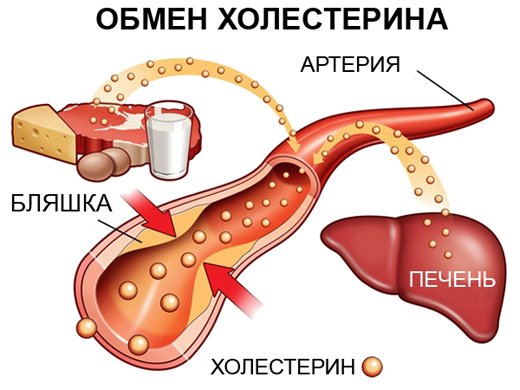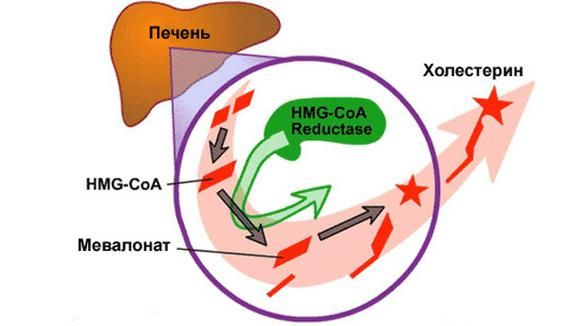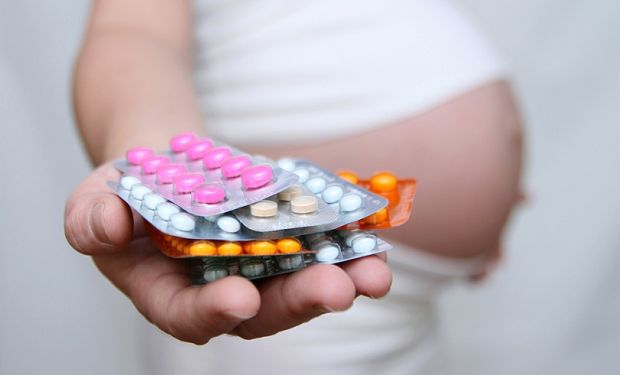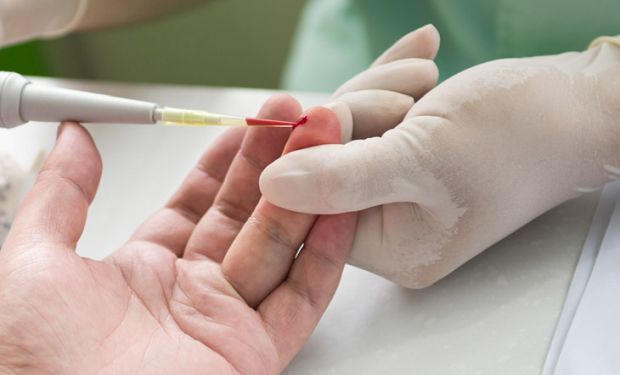For people who have high cholesterol in their blood, information becomes relevant whether statins are harmful for lowering cholesterol. Once the lipid profile shows deviations from the norm in lipoproteins, doctors prescribe expensive drugs that are part of the statin group. Everything would be fine, but patients are alarmed by the fact that their admission becomes permanent, that is, until the end of their lives.
About cholesterol
Cholesterol is one of the important organic compounds produced in the liver. Without it, the existence and division of cells, as well as the production of sex and other hormones, is not possible. However, cholesterol compounds are heterogeneous. It functions in two types:
- Harmful (LDL) - low-density lipoproteins
- Beneficial (HDL) - high-density lipoproteins
LDL has an atherogenic effect and contributes to the occurrence of the following pathologies:
- atherosclerosis
- BP caused by hypertension
- myocardial infarction
- atherosclerosis
- ischemia
If a high concentration of LDL is detected, the question of whether it is necessary to lower cholesterol with pills is not considered. This group of drugs is prescribed without fail.
What are statins
These pharmacological drugs are aimed at blocking liver and adrenal enzymes that contribute to the production of cholesterol. What effect do statins have and whether you need to take them for cholesterol is stated in the instructions included with the medications:
- the substances contained in the tablets actively inhibit HMG reductase, as a result of which the synthesis of fats by the liver is reduced and the content in the plasma is reduced
- low molecular weight cholesterol, which is not amenable to lipid-lowering drugs, is reduced
- total cholesterol is reduced by 45%, low-density lipoproteins are reduced by 55-60%
- high molecular weight (good) cholesterol increases significantly
- the risk of developing coronary heart disease and stroke is reduced by 15-20%
Statins are divided into several generations, have different price categories and differ in effectiveness.
Indications for use
Whether to take statins for high cholesterol permanently or temporarily can be determined after a full examination by a doctor. In some cases, these groups of substances can harm the body, so for high cholesterol, doctors prescribe completely different drugs.
Modern methods include statins in the therapeutic treatment of cardiac pathologies. This reduces mortality among patients and enhances the effect of treatment. However, even for elderly patients, doctors cannot prescribe statins for cholesterol without a preliminary examination, the benefits and harms of which are in equal proportions.

Absolute readings:
- for the prevention of ischemic stroke and myocardial infarction
- during preparation for vascular operations and in the postoperative period after stenting, bypass surgery and other types of interventions
- after the development of severe coronary diseases and heart attack
- ischemic disease, threatening the development of heart failure
Relative indications for statins for cholesterol, the benefit of which is questionable:
- low risk of developing myocardial infarction
- young and older women before menopause
- patients with diabetes mellitus types 1 and 2
The question of whether to take cholesterol pills in childhood is decided by experts. Statins are prescribed to children in extreme cases, when there are serious pathologies caused by hereditary hypercholesterolemia and heart disease.
Selection of tablets
Based on the patient’s complaints and data obtained after the examination, the attending physician decides whether it is necessary to take statins for cholesterol. If the decision is positive, a suitable group of drugs is selected, taking into account all concomitant acute and chronic diseases. It is strictly forbidden to do this yourself.
When prescribing statins, the doctor also determines the dosage of the drug, which may vary depending on changes in blood composition. To do this, the patient will have to regularly donate blood for analysis to adjust the dose and type of statins.
It is necessary to pay attention to how statins are harmful for cholesterol:
- Older people taking medications for diabetes and hypertension may experience muscle wasting after taking statins
- for patients with chronic liver pathologies, groups that do not affect this organ are recommended (pravastatins, rosuvastatins)
- Pravastatin is indicated for patients suffering from muscle pain
In case of kidney dysfunction, Lescol (“fluvastatin”) and Lipitor (“atorvastatin”) are prohibited, as they are highly toxic
- It is allowed to take two types of statins with a significant reduction in the dosage of each
- the combination of statins and nicotinic acid is unacceptable. This can lead to a drop in blood glucose and intestinal bleeding.
If the doctor has prescribed expensive drugs, you cannot replace them with cheaper analogues yourself.
Cholesterol level for statin prescription
It is also necessary to find out whether you need to take statins if you have mildly elevated cholesterol. Constantly reducing fat can lead to exhaustion, anemia and other dangerous pathologies. A person cannot live without cholesterol. It is only necessary to get rid of LDL, which adheres to the vascular walls and forms atherosclerotic plaques. HDL is a kind of fuel that helps get rid of “harmful” lipoproteins. Accordingly, its content, even if it is increased, should not worry the patient. This means that human blood vessels are completely protected.
You can find out the amount of both types only with a detailed blood test, which can be done in highly qualified laboratories.
Harm of statins

Statins against cholesterol bring not only benefits, but also harm. The norm of drugs does not provide anything useful other than lowering cholesterol. In addition, these drugs have many side effects that can even lead to death. Among them note:
- weakness
- muscle pain
- rapid fatigue
- decreased sexual activity (mainly in men)
- weakening of memory and concentration
Pregnant and breastfeeding women and people with allergic reactions should not take statins. Studies have shown that these medications increase the likelihood of developing cataracts by 50 percent or more. And if taking statins is accompanied by diabetes, this risk increases to 82%. Therefore, doctors are in no hurry to recommend statins to people who do not have a history of heart disease or a pre-stroke condition.
Should I take statins?
Knowing the harm of these drugs, a person may refuse treatment in this way. But you can make the final choice only by correctly comparing all the pros and cons:
- The acceptable level of low-density lipoproteins (LDL), which is no more than 100 mg/dl, should push one away from statins
- If you start taking statins, you will have to do it for life. If the patient decides to quit treatment, his situation will sharply worsen several times compared to the initial condition
- many will not be satisfied with the high cost of drugs
- It is necessary to monitor for side effects, as dangerous health risks may arise
After consulting with a medical specialist, everyone must decide for themselves whether they need to take cholesterol pills. Drug therapy is a personal matter for everyone.
If a patient is afraid or for some other reason refuses statins, doctors offer alternative options. One of these could be a special diet. Natural statins are found in large quantities in many foods: berries, fruits, fish oil, flaxseed oil, garlic.
Statins for cholesterol are selected by the doctor according to the individual characteristics of the patient.
Doctor Myasnikov's opinion on the treatment of high cholesterol
Cholesterol is necessary for the body, as it is involved in many vital processes. Only 20% of the fat-like substance comes with food, and the rest is synthesized in the liver.
Therefore, even vegetarians may have high cholesterol levels. A contributing factor may be heredity, a sedentary lifestyle, bad habits, and impaired carbohydrate metabolism.
For hypercholesterolemia, statins are often prescribed, which reduce the likelihood of complications. But, like any other medicine, these drugs have their drawbacks. Dr. Alexander Myasnikov will help you understand why high cholesterol is dangerous and what role statins play in lowering it.
What is cholesterol and why can it be dangerous?
Cholesterol is solid bile or lipophilic alcohol. The organic compound is an integral part of cell membranes, which makes them more resistant to temperature changes. Without cholesterol, it is impossible to produce vitamins D, bile acids and adrenal hormones
The human body produces approximately 80% of the substance itself, mainly in the liver. The remaining 20% of cholesterol comes from food.
Cholesterol can be good and bad. The chief physician of City Clinical Hospital N°71, Alexander Myasnikov, draws the attention of his patients to the fact that the beneficial or negative effect of a substance on the body depends on the density of the lipoproteins that make up the organic compound.
In a healthy person, the ratio of LDL to LDL should be equal. But if the levels of low-density lipoproteins are too high, then the latter begin to settle on the walls of blood vessels, leading to adverse consequences.
Doctor Myasnikov claims that levels of bad cholesterol will increase especially rapidly if the following risk factors are present:
- diabetes;
- hypertension;
- overweight;
- smoking;
- poor nutrition;
- vascular atherosclerosis.
Consequently, the primary cause of strokes and heart attacks around the world is an increase in the level of bad cholesterol in the blood. LDL is deposited on blood vessels, forming atherosclerotic plaques, which contribute to the formation of blood clots, which often leads to death.
Myasnikov also talks about cholesterol for women, that it is especially harmful after menopause. After all, before the onset of menopause, the intensive production of sex hormones protects the body from the appearance of atherosclerosis.
If cholesterol levels are high and the risks are low, drug treatment is not prescribed.
However, the doctor is convinced that if a patient’s cholesterol is not higher than 5.5 mmol/l, but there are risk factors (increased blood glucose, obesity), then he should definitely take statins.
Statins for hypercholesterolemia
Statins are a leading group of drugs that help reduce harmful cholesterol to acceptable levels. These drugs significantly reduce the risk of developing cardiovascular diseases, although Dr. Myasnikov emphasizes to patients that medicine still does not know the exact principle of their action.
The scientific name of statins is HMG-CoA reductase inhibitors. They are a new group of drugs that can quickly lower LDL levels and increase life expectancy.
Presumably, the statin slows down the function of the liver enzyme that synthesizes cholesterol. The drug increases the number of LDL apolyprotein and HDL receptors in cells. Thanks to this, harmful cholesterol lags behind the vascular walls and is utilized.
Dr. Myasnikov knows quite a bit about cholesterol and statins, since he himself has been taking them for many years. The doctor claims that in addition to their lipid-lowering effect, liver enzyme inhibitors are highly valued due to their positive effects on blood vessels:
- stabilize plaques, reducing the risk of their rupture;
- eliminate inflammation in the arteries;
- have an anti-ischemic effect;
- improve fibirinolysis;
- strengthen the vascular epithelium;
- have an antiplatelet effect.
In addition to reducing the likelihood of developing diseases of the cardiovascular system, the benefit of statins is to prevent the occurrence of osteoporosis and intestinal cancer. HMG-CoA reductase inhibitors prevent the formation of gallstones and normalize kidney function.
Doctor Myasnikov draws attention to the fact that statins are very useful for men. The drugs help with erectile dysfunction.
All statins are available in tablet form. They are taken once a day before bedtime.
But before taking statins, you should take urine and blood tests and do a lipid profile to detect disorders in fat metabolism. In severe forms of hypercholesterolemia, you will need to take statins for several years or throughout your life.
Liver enzyme inhibitors are distinguished by chemical composition and generation:
| Generation | Features of the drugs | Popular products from this group |
| I | Made from penicillin mushrooms. Reduce LDL by 25-30%. They have a significant number of side effects. | Lipostat, Simvastatin, Lovastatin |
| II | Inhibits the process of enzyme release. Reduce total cholesterol concentration by 30-40%, can increase HDL by 20% | Leskol, Fluvastatin |
| III | Synthetic drugs are highly effective. Reduce total cholesterol by 47%, increase HDL levels by 15% | Novostat, Liprimar, Torvacard, Atoris |
| IV | Synthetic statins of the latest generation. Reduces bad cholesterol levels by 55%. Have a minimum number of adverse reactions | Rosuvastatin |
Despite the high effectiveness of statins for hypercholesterolemia, Dr. Myasnikov points out the likelihood of developing negative consequences after taking them. First of all, medications negatively affect the liver. Also, liver enzyme inhibitors in 10% of cases can affect the muscular system, sometimes contributing to the appearance of myositis.
There is an opinion that statins increase the risk of type 2 diabetes. However, Myasnikov is convinced that if you take the tablets in an average dosage, your glucose levels will rise only slightly. Moreover, for diabetics, vascular atherosclerosis, which leads to heart attacks and strokes, is much more dangerous than a minor disturbance in carbohydrate metabolism.
A number of studies have shown that in some cases statins impair memory and can change human behavior. Therefore, if such adverse reactions occur after taking statins, you should contact your doctor, who will adjust the dosage or discontinue use of the drug.
Natural statins
For people who are not at risk and whose cholesterol is slightly elevated, Myasnikov recommends lowering the fatty alcohol content in the blood naturally. LDL and HDL levels can be normalized with diet therapy.
Other foods that remove cholesterol from the body:
- coffee;
- cocoa;
- Chinese red rice;
- green tea;
Speaking about high cholesterol, Dr. Myasnikov recommends that his patients replace animal fats with vegetable fats. Unrefined flaxseed, sesame or olive oil, which strengthens vascular walls, is especially beneficial for the body.
Alexander Leonidovich advises all people suffering from hypercholesterolemia to consume fermented milk products daily. Thus, natural yogurt contains a sterol that reduces bad cholesterol levels by 7-10%.
You also need to eat plenty of fiber-rich vegetables and fruits. Solid fibers bind and remove LDL from the body.
In the video in this article, Dr. Myasnikov will talk about high cholesterol levels.
The benefits and harms of statins
Modern lipid-lowering therapy aimed at reducing cholesterol levels is one of the promising areas for the treatment of atherosclerosis. The leading positions in medical prescriptions for patients with high cholesterol are occupied by statins - drugs that reduce the production of “bad” fat fractions.
Despite the effectiveness of statin therapy, recently the scientific world has increasingly published studies on the dangers of long-term use of these drugs. The negative impact on the liver and other internal organs prevents patients with chronic diseases from taking these drugs, and the need for long-term use of statins can cause dangerous side effects. Statins have not only beneficial but also harmful properties: the pros and cons of taking these lipid-lowering drugs are presented in the review below.
When are statins prescribed?
Before describing in detail the side effects and harm of representatives of the statin group to the body, it is necessary to find out when a doctor can prescribe these drugs.

Statins are lipid-lowering drugs, the mechanism of action of which is associated with selective inhibition of the enzyme HMG CoA reductase, a key link in the formation of cholesterol and its atherogenic fractions. Indications for the use of statins:
- as part of complex therapy for hypercholesterolemia (high cholesterol);
- with hereditary forms of hypercholesterolemia (familial heterozygous, homozygous);
- correction of fat metabolism in case of risk or advanced clinical picture of cardiovascular and cerebrovascular pathology.
Principles for prescribing statins
- before using medications, all patients with hypercholesterolemia should be recommended methods for correcting fat metabolism through diet and adequate physical activity, and giving up bad habits;
- If cholesterol levels do not return to normal within three months of non-drug treatment, doctors usually prescribe statins;
- statins based on atorvastatin and simvastatin begin to act after 2 weeks of regular use, those based on rosuvastatin - a little faster. The maximum therapeutic effect of the drugs develops after a month of use and lasts the entire course of treatment;
- Statin therapy is usually long-term, taking months or even years.
Mechanism of action of statins
Statins “work” at the biochemical level by blocking one of the key enzymes for cholesterol synthesis in the liver. Thus, the drugs have the following pharmacological effects:
- already within the first month the initial cholesterol concentration is noticeably reduced;
- reduces the production of “harmful” atherogenic lipids – LDL cholesterol, VLDL, TG;
- Unstably increase the concentration of the “beneficial” fraction of cholesterol - HDL.
In addition, by increasing the number of HDL receptors on the surface of hepatocytes, statins increase their utilization by liver cells. Thus, the disturbed ratio of high- and low-density lipoproteins is restored, and the atherogenicity coefficient returns to normal.

The benefits of statins are:
- reducing the risk of ischemic manifestations in patients with insufficient blood supply to the heart and brain;
- prevention of cardiovascular diseases in persons with risk factors (age over 60 years, smoking, alcohol abuse, diabetes, etc.);
- reducing the risk of fatal complications of coronary artery disease and dyscirculatory encephalopathy;
- improving the quality of life of patients.
Statins prolong life
It is no secret that patients with high cholesterol levels and clinical manifestations of atherosclerosis are at risk of encountering such serious complications as acute myocardial infarction, circulatory disorders in the vessels of the extremities and internal organs, and stroke.
All these conditions are connected by a common mechanism for the development of a pathological effect:
- Increased concentration of total cholesterol and its atherogenic fractions in the blood (LDL).
- The deposition of lipids on the walls of blood vessels, their strengthening by the connective tissue framework - the formation of an atherosclerotic (cholesterol) plaque.
- Impaired blood supply to internal organs through arteries narrowed due to cholesterol deposition on the walls of the arteries. First of all, the heart muscle and brain suffer, since they are the ones who need a constant supply of oxygen and nutrients;
- The appearance of the first symptoms of ischemia: if the heart is damaged - unpleasant pressing pain behind the sternum, shortness of breath, decreased tolerance to physical activity; with insufficient oxygen supply to the brain - dizziness, forgetfulness, headaches.
If you do not pay attention to these symptoms in time, circulatory failure will progress rapidly and can lead to life-threatening consequences - a heart attack or stroke.
Cardiac muscle infarction is an irreversible physiological change in heart tissue, including necrosis (cell death) and aseptic inflammation. The condition manifests itself as sharp pain in the heart area, panic, and fear of death. If necrosis affects the entire wall of the organ, the infarction is called transmural. In case of a favorable outcome, the area of necrosis is “tightened” by connective tissue, and the patient is forever left with a scar on the heart.

If the damage is too extensive, the heart cannot perform its function of pumping blood. In an unfavorable version of the course of a heart attack, heart failure, pulmonary edema and sometimes the death of the patient occur.
A stroke, a disruption of the blood supply to an area of the brain, can also be fatal. If ischemic damage has developed in a vital area of the brain, death can occur instantly. All dangerous complications of atherosclerosis develop suddenly and require immediate hospitalization.
The benefits of statins in the prevention and treatment of atherosclerosis are invaluable: these drugs keep cholesterol levels within target values, prevent the formation of atherosclerotic plaques and significantly reduce the risk of heart attack and stroke due to atherosclerosis. In addition, statins reduce mortality from recurrent heart attacks and strokes in patients with high blood cholesterol concentrations, severe atherosclerosis and circulatory disorders.
Harm of statins
In the 2000s, there was a real “boom” for statins in medicine: the drugs were prescribed even to those whose cholesterol was slightly elevated, and the condition could be corrected with the right diet. After several years of unjustified popularity of the drugs atorvastatin, simvastatin and other statins, studies began to be published on the negative impact of these drugs on the functioning of internal organs. Some publications categorically stated: the benefits and harms of statin treatment are equivalent.
Harmful effects on the liver
As you know, it is in the liver that up to 80% of the so-called endogenous cholesterol is produced. When treated with statins, synthesis processes are disrupted, and precursor products of atherogenic lipid fractions can have dangerous harmful effects on hepatocytes.
On the other hand, destruction of liver cells does not occur in all patients. It is not difficult to track the harm caused by statins: it is enough to regularly monitor laboratory parameters and take liver tests.
Liver test analysis includes two indicators:
- Alanylamimotransferase (ALAT, ALT) – normal 0.12-0.88 mmol/l;
- Aspartate aminotransferase (AST, AST) – the norm is 0.18-0.78 mmol/l.
In addition, it is advisable to take tests for total and direct/indirect bilirubin - these indicators are often used by therapists to assess liver function. An increase in bilirubin may indicate severe disorders at the hepatic cellular level. In this case, the use of statins is not recommended.
By their chemical and biological nature, AlAT and AST are enzymes that enter the blood during the destruction of liver cells. Normally, hepatocytes are regularly renewed: old ones die off and new ones take their place. Therefore, these substances are present in minimal concentrations in the blood.
But if for some reason the death of hepatocytes increases (be it the toxic effects of poisons and drugs, chronic liver diseases, etc.), then the content of these enzymes increases several times. If you take statins for a long time, liver tests can exceed normal values by 2-4 times.
The ideal option for a patient just starting to take statins would be to take a liver test before starting treatment and after 1-2 months of regular use of the drugs. If ALT and AST are within normal limits according to the results of the first and second analysis, then statins do not have a harmful effect on the patient’s liver, and therapy with them will benefit the body. If, before taking the drugs, liver tests were normal, but then sharply increased, then, unfortunately, statins do much more harm to the patient’s liver than benefit the blood vessels. In this case, it is necessary to consult a doctor to choose further treatment tactics. The following options are possible:
- Cancellation of statins. Often, when the concentrations of ALT and AST become dangerous to health, the only correct step for a specialist is to completely discontinue the drug. To avoid harm, which in this case significantly outweighs the benefit, it is recommended to switch to other groups of lipid-lowering drugs only after liver test results have been restored. In addition, patients should not forget that the main method of treating high cholesterol and atherosclerosis remains a diet with a minimum content of animal fats and moderate physical activity.
- Dose adjustment. The dosage regimen for almost all statins is the same: the drug is prescribed once a day, the minimum recommended dose is 10 mg, the maximum is 80 mg. The process of selecting a dose suitable for the patient can take a long time: at the beginning of therapy, as a rule, all people with atherosclerosis and high cholesterol are prescribed to take a statin with a dosage of 10 mg. Then, after 2-4 weeks from the start of regular use of the drug, the patient is prescribed control tests for cholesterol and atherogenic lipids, and the result is assessed. If 10 mg of the drug does not “cope”, and the initial cholesterol level remains at the same level or has increased, then the dosage is doubled, i.e. up to 20 mg. So, if necessary, you can gradually increase the dose of statins taken to 80 mg.
The higher the dosage of medication a patient needs to take, the more damage statins cause to the liver. Therefore, for patients who take 80 mg of the drug daily and are faced with its dangerous effects, the dose of the drug can be reduced (on the recommendation of a doctor).
- Other recommendations for statin treatment are selected individually.
In addition, all patients taking statins need to be aware of their dangerous effects on the liver and try to protect the organ from the negative influence of the environment:
- limit consumption of fatty foods fried in oil;
- Quit alcohol and smoking;
- Do not take other medications without a doctor's recommendation.
Dangerous effects on muscles and joints
Another fairly common side effect of statins is related to their effect on skeletal muscle. In some patients, the drugs cause intense muscle pain (aching, pulling), especially in the evening after an active day.
The mechanism of myalgia development is associated with the ability of statins to destroy myocytes - muscle cells. In place of the destroyed cells, a response inflammation develops - myositis, lactic acid is released and further irritates the nerve receptors. Muscle pain when taking statins is very similar to the discomfort after intense physical activity. The muscles of the lower extremities are most often affected.
Rhabdomyolysis is a syndrome that is a critical degree of myopathy. The condition is manifested by a sudden massive death of a large section of muscle fiber, absorption of decay products into the blood and the development of acute renal failure. In other words, the kidneys fail, unable to cope with the volumes of toxic substances that need to be removed from the body. If rhabdomyolysis develops, the patient must be urgently hospitalized in the ICU to monitor vital functions.
To prevent the development of this dangerous syndrome, all patients taking statins are recommended to include in their regular examination plan a test for creatine phosphokinase (CPK), an enzyme contained in myocytes and released into the blood during necrosis of muscle tissue. The normal level of CPK in the blood is 24-180 IU/l. If this indicator increases in control tests, it is recommended to stop using statins or reduce the dosage.

Less commonly, patients taking statins experience dangerous joint complications. The harm of cholesterol-lowering drugs lies in changes in the amount and physicochemical properties of intra-articular fluid. Due to this, patients develop arthritis (especially large joints - knee, hip) and arthrosis. If such a patient is not provided with timely assistance, as the condition progresses, joint contractures may develop - pathological fusion of its key elements. Due to this, active movements in the joint become increasingly difficult, and soon it becomes absolutely motionless.
Harm of statins to the digestive system
The most common harmful side effects of statins, which do not have a dangerous effect on life and health, are dyspepsia. In 2-3% of cases, while taking medications to lower blood cholesterol levels, the following occur:
- nausea;
- vomit;
- non-localized abdominal pain;
- belching;
- increased appetite or, conversely, refusal to eat.
In addition, in rare cases, patients taking drugs based on atorvastatin, simvastatin or other statins may develop inflammatory or erosive-ulcerative damage to the mucous membrane of the mouth, esophagus (esophagitis), stomach and intestines (gastroenteritis). Treatment of these conditions is carried out according to general principles; statins are canceled for this period. In the future, for the treatment of atherosclerosis and high cholesterol levels, it is better to select products with another active ingredient.
Harm to the nervous system
Taking statins can cause the following side effects from the nervous system:

- headache;
- insomnia, changes in sleep quality, nightmares;
- drowsiness;
- dizziness;
- severe asthenia (weakness, fatigue, malaise);
- memory loss;
- sensitivity disorders - loss or, conversely, the appearance of pathological sensations in the limbs or other parts of the body;
- perversion of taste;
- emotional lability (instability) – rapid changes in moods and expressed emotions, tearfulness, touchiness;
- paralysis of the facial nerve, manifested by facial asymmetry, loss of motor activity and sensitivity on the affected side.
You need to understand that not all of these side effects will develop in a particular patient. In general, the incidence of each does not exceed 2% (according to a clinical study with more than 2500 subjects). Since the instructions must indicate all the possible effects of statins on the body, which developed at least once during clinical trials, this list looks impressive. In fact, most patients with atherosclerosis who take statins will not encounter dangerous effects of the drugs on the nervous system.
Harm to the heart and blood vessels
Despite the invaluable benefits that statins have on the cardiovascular system, occasionally, in 1-1.5% of cases, side effects from the circulatory system may develop. These include:
- feeling of heartbeat;
- dilatation of peripheral vessels, drop in blood pressure;
- migraine caused by changes in cerebral vascular tone;
- occasionally – hypertension;
- arrhythmia;
- in the first weeks of use - increased manifestations of angina pectoris, then normalization of the condition.
Dangerous respiratory side effects

The harm of statins in relation to the respiratory system is:
- a slight decrease in immunity and the development of an infectious process in the upper respiratory tract (sinusitis, rhinitis, pharyngitis);
- progression of the infection and its spread to the lower respiratory organs (bronchitis, pneumonia);
- breathing problems - dyspnea;
- bronchial asthma of mixed origin;
- nosebleeds.
Harm to the kidneys and urinary system
The negative effect of statins on the urinary system is:
- development of urogenital infections due to local decrease in immunity;
- infection with opportunistic flora and the appearance of signs of cystitis - frequent urination, pain in the projection of the bladder, pain and burning at the time of urine excretion;
- impaired renal function, the appearance of peripheral edema;
- changes in laboratory urine tests: microalbuminuria and proteinuria, hematuria.
Allergic reactions
Hypersensitivity events occur rarely during treatment with statins. Patients taking statins to lower cholesterol may experience:

- skin rash;
- itching;
- generalized or local edema;
- contact dermatitis;
- hives.
The development of anaphylactic shock, dangerous skin syndromes (Lilela, Stevens-Jones) and other severe allergic reactions was recorded in isolated cases during post-marketing studies. Therefore they are considered casuistry.
Harmful effects of statins on the fetus
Treatment with statins in pregnant and lactating women is strictly prohibited. In addition, if therapy with cholesterol-lowering drugs is recommended for a woman of reproductive age (15-45 years, or older - before menopause), then before starting treatment she should make sure that there is no pregnancy, and during treatment use effective methods of contraception .

Statins belong to drugs from the X-category of action on the fetus. No studies have been conducted on humans, but experiments on laboratory animals revealed that administration of atorvastatin-based drugs to pregnant female rats causes a significant decrease in the weight of the pups born. Also in medicine, there is one case of the birth of a child with multiple malformations after the mother took the drug Lovastatin in the first trimester of pregnancy.
In addition, cholesterol is an essential substance for normal growth and development of the fetus. Statins easily cross the blood-placental barrier and accumulate in high concentrations in the child’s blood. Since these drugs, by inhibiting HMG-CoA reductase, significantly reduce cholesterol synthesis in the liver, the fetus may experience a significant deficiency of this fatty alcohol and its derivatives.
Features of statin treatment
Before the doctor selects the necessary drug from the group of statins for you, it is advisable to undergo a full examination of the body and pass:
- general clinical analysis of blood and urine - to determine the general functions of the body;
- lipid profile - a complete study of the state of fat metabolism in the body with the determination of total cholesterol, its atherogenic and antiatherogenic fractions, triglycerides and the risk factor for cardiovascular and cerebrovascular complications of atherosclerosis in each individual patient;
- biochemical analysis, including determination of: total and direct/indirect bilirubin, ALT and AST, CPK, creatine and urea to determine kidney function.

If these examinations are within normal limits, then there are no contraindications to the prescription of statins. A month after starting medication, it is advisable to repeat the entire examination to determine the tactics for further action. If all tests are within normal limits, then statins for lowering cholesterol are suitable for the patient and bring more benefit than harm.
If control tests reveal abnormalities in the liver, skeletal muscles or kidneys in patients, statin therapy does more harm than good.
Statins: pros and cons
Despite debates in the scientific world as to whether statins have more benefit or harm, doctors prescribe these drugs to a large number of patients with high cholesterol every day. All the pros and cons of taking HMG CoA reductase inhibitors are presented in the table below.
| control cholesterol levels, significantly reducing it within the first month of treatment | not suitable for patients with chronic liver pathology: can cause massive necrosis of hepatocytes and liver failure |
| reduce the risk of developing coronary artery disease and dyscirculatory encephalopathy in healthy patients with high cholesterol levels | have a large number of side effects, including those harmful to the body |
| reduce the risk of developing fatal complications of cardiovascular and cerebrovascular pathology in chronic patients by 25-40% | The incidence of side effects is 0.3-2% |
| reduce mortality from heart attack and stroke | cannot be used by pregnant, lactating women and children under 10 years of age |
| suitable for the treatment of genetically determined forms of hypercholesterolemia | require long-term use (months and even years), and the risk of side effects increases |
| easy to use: you only need to drink once a day | do not combine well with other medications |
| suitable for the treatment of atherosclerosis in patients with chronic renal pathology: excreted mainly by the liver | |
| usually well tolerated by patients, including the elderly |
After statins were introduced into medical practice and became widely used, mortality from acute cardiovascular and cerebrovascular pathologies decreased by 12-14%. On a Russian scale, this means approximately 360,000 lives saved annually.














